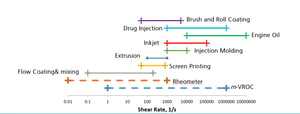In simplest terms, viscosity is defined as “the resistance to flow” and is often referred to as the thickness of a fluid. The concept of a fluid having a “thickness” has existed for thousands of years, however the term “viscosity” was not introduced until 1929. Even Newton referred to viscosity as “the lack of slipperiness of the parts of the liquid” (Sir Isaac Newton, Principia, 1687).
When you think of a viscometer, what primarily comes to mind is an instrument capable of measuring viscosity. However, we know viscosity can be calculated, but cannot be measured directly. Viscosity can be calculated using various methods and there are numerous viscometers on the market today, but not all viscometers are made alike.
|
Falling Ball |
Spindle Type |
Rotational |
Rectangular Slit Method |
Funnel Type |
Glass Capillary |
Oscillating Piston |
Stabinger |
Bubble |
|
|
Sample Size |
mL (some require 40 mL!) |
mL (6.7 - 16 mL) |
2 - 20mL |
µl (26-100) |
Large |
mL |
mL (1.5 mL - 6 mL) |
mL (1.5 - 6 mL) |
mL |
|
Primary Measurement |
Time (Terminal Viscosity) |
Torque |
Stress Control or Shear Control |
Pressure Drop |
Time |
Time |
Shear Stress |
Shear Stress |
Time |
|
Viscosity Measured |
Dynamic |
Dynamic |
Dynamic |
Dynamic |
Kinematic |
Kinematic |
Kinematic |
Kinematic |
Kinematic |
|
Shear Rate Variation |
Yes (Must change the angle) |
Yes |
Yes |
Yes |
No |
No |
Yes |
No |
No |
|
Laws/ Principle applied |
Stoke’s Law, Hoeppler Principle |
Couette/Searle |
Couette/Searle |
Hagen-Poiseuille Flow |
Time |
Gravimetric Flow |
Electromagnetic |
Couette |
Time |
|
Benefits |
"Repeatable" Wide variety of sample capability |
ASTM standards |
Accurate characterization of shear rates
|
Small sample volumes Accurate measurements Easy to use Low reynolds numbers |
Quick quality control |
Simple design |
ASTM Standards |
Measures kinematic and dynamic viscosity also density |
Quick quality control |
|
Limitations |
Rely on Gravity-driven flow Shear rates not controlled or changed
|
Hard to reproduce measurements |
Evaporation Irreversible adsorption of protein molecules at the interface
|
Careful attention to cleaning and fibers
|
Rely on Gravity-driven flow Shear rates not controlled or changed
|
End user variation easy to break and lose track of measurement No Viscoelastic characterization |
Variation from end users No Viscoelastic characterization |
No Viscoelastic characterization |
No Viscoelastic characterization End user dependent |
When measuring viscosity, it is important to know if the fluid you are working with is Newtonian or non-Newtonian. Viscosity of Newtonian fluids is constant and therefore independent of shear rate whereas the viscosity of non-Newtonian fluids is not constant and therefore dependent on shear rate. (1) Many viscometers on the market today are only capable of accurately measuring viscosity of Newtonian fluids, when in reality most fluids are non-Newtonian. And, often only approximate the apparent properties of fluids, failing to quantify the absolute or true viscosity, which is one of the most important parameters in the development and modeling of applications that involve fluid flow. Behavior of Non-Newtonian fluids affects both production and how they are applied (ex: injectability, lubrication, spreading, jetting or drinking). Viscometers that don’t allow you to control shear stress or shear rate cannot adequately characterize Non-Newtonian liquids, and it is difficult to understand your sample’s behavior under production or application conditions without the ability to test under these same conditions.
| Common Newtonian fluids: (linear relationship between shear stress and shear rate) |
Common non-Newtonian fluids: (viscosity is not independent of shear rate) |
|
|

RheoSense viscometers are powered by our patented VROC® (Viscometer-Rheometer-on-a-Chip) technology. VROC combines microfluidic and MEMS (Micro-Electro-Mechanical Systems) technologies to measure dynamic viscosity over a wide dynamic range of operation, delivering data with the highest accuracy and repeatability. Compared to conventional viscometers and rheometers, RheoSense’s rectangular slit method viscometers (USP chapter 914) offer several advantages:
- Small sample size requirement (26µL – 100µL)
- Cost-effective
- Characterization of both Newtonian & non-Newtonian fluids
- Enable high shear rates without flow instabilities
- Prevent evaporation and contamination of samples
- Render high throughput due to a simple flow-through design
Learn more about how RheoSense’s VROC technology works here! If you’re ready to see our technology in action, contact us to schedule a free demo of any of our VROC powered viscometers!
Written by: Eden Reid, RheoSense Senior Marketing Associate



